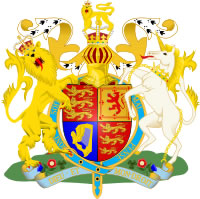 |
Kings and Queens of England Since 1066
Today the British monarchy may strike some as an anachronism, but for centuries people all over the world assumed that the hand of providence controlled the destiny of nations, and the that king, queen or emperor ruled by divine right. While the authority of the Crown was generally accepted as absolute, the signing of the Magna Carta by King John in 1215 recognized that the powers of the king were not unlimited, and that certain of his subjects had rights upon which the king or queen could not impinge. Although the current monarch, Queen Elizabeth II, has very little political power, her ceremonial duties confer upon her significant status. In her naming of the Prime Minister following elections, she demonstrates her status as the moral leader of the nation, a person above politics who has the right—indeed the duty—to support policies that benefit all the subjects of her realm. That is no small charge, and her influence of the affairs of state is still seen as fitting and proper. |
NORMAN AND PLANTAGENET
- WILLIAM I (Conqueror) 1066-1087
- WILLIAM II (Rufus) 1087-1100
- HENRY 1100-1135
- STEPHEN 1135-1154 Maude, daughter of Henry I, also claimed crown
- HENRY II 1154-1189 m. Eleanor of Aquitaine
- RICHARD I (Lionhearted) 1189-1199
- JOHN 1199-1216 Signed the Magna Carta in 1215
- HENRY III 1216-1272
- EDWARD I 1272-1307
- EDWARD II 1307-1327
- EDWARD III 1327-1377 Hundred Years' War begins
- RICHARD II 1377-1399
- HENRY IV 1399-1413
HOUSES of LANCASTER and YORK
- HENRY V 1413-1422 Battle of Agincourt, 1415
- HENRY VI 1422-1461
- EDWARD IV 1461-1483
- EDWARD V 1483
- RICHARD III 1483-1485 Defeated by Henry Tudor at Bosworth Field, 1485
HOUSE OF TUDOR
- HENRY VII 1485-1509
- HENRY VIII 1509-1547 English Reformation: Breaks with Rome
- EDWARD VI 1547-1553 Son of Henry VIII by Jane Seymour
- LADY JANE GREY, 1554
- MARY (“Bloody Mary”) 1554-1558 Daughter of Henry VIII by Catherine of Aragon
- ELIZABETH I (The Great) 1558-1603 Daughter of Henry VIII by Anne Boleyn; Spanish Armada, 1588
HOUSE of STUART
- JAMES I (VI of Scot.) 1603-1625; King James Bible, 1611
- CHARLES I 1625-1649 Executed 1649 after being tried by Parliament for treason
- The PROTECTORATE 1649-1660 Oliver Cromwell is Lord Protector, succeeded by son Richard in 1558
- CHARLES II 1660-1685 The Restoration. Charles was son of Charles I
- JAMES II 1685-1688 Overthrown in the "Glorious Revolution" of 1688
- WILLIAM and MARY 1689-1694
- WILLIAM III 1689-1702 House of Orange
- ANNE 1702-1714 Last of the Stuarts
HOUSE of HANOVER
- GEORGE I 1714-1727
- GEORGE II 1727-1760
- GEORGE III 1760-1820 American Revolution, 1775-1783
- GEORGE IV 1820-1830
- WILLIAM IV 1830-1837
- VICTORIA 1837-1901 SAXE-COBURG (Prince Albert) The Longest reigning British Monarch until Queen Elizabeth II.
- EDWARD VII 1901-1910
HOUSE of WINDSOR (1917)
- GEORGE V 1910-1936
- EDWARD VIII 1936 Abdicated to Marry Mrs. Wallis Simpson (Duke and Duchess of Windsor)
- GEORGE VI 1936-1952
- ELIZABETH II 1952-2022 Elizabeth was the longest-lived and longest-reigning monarch in British history.
- CHARLES III 2022--
|
